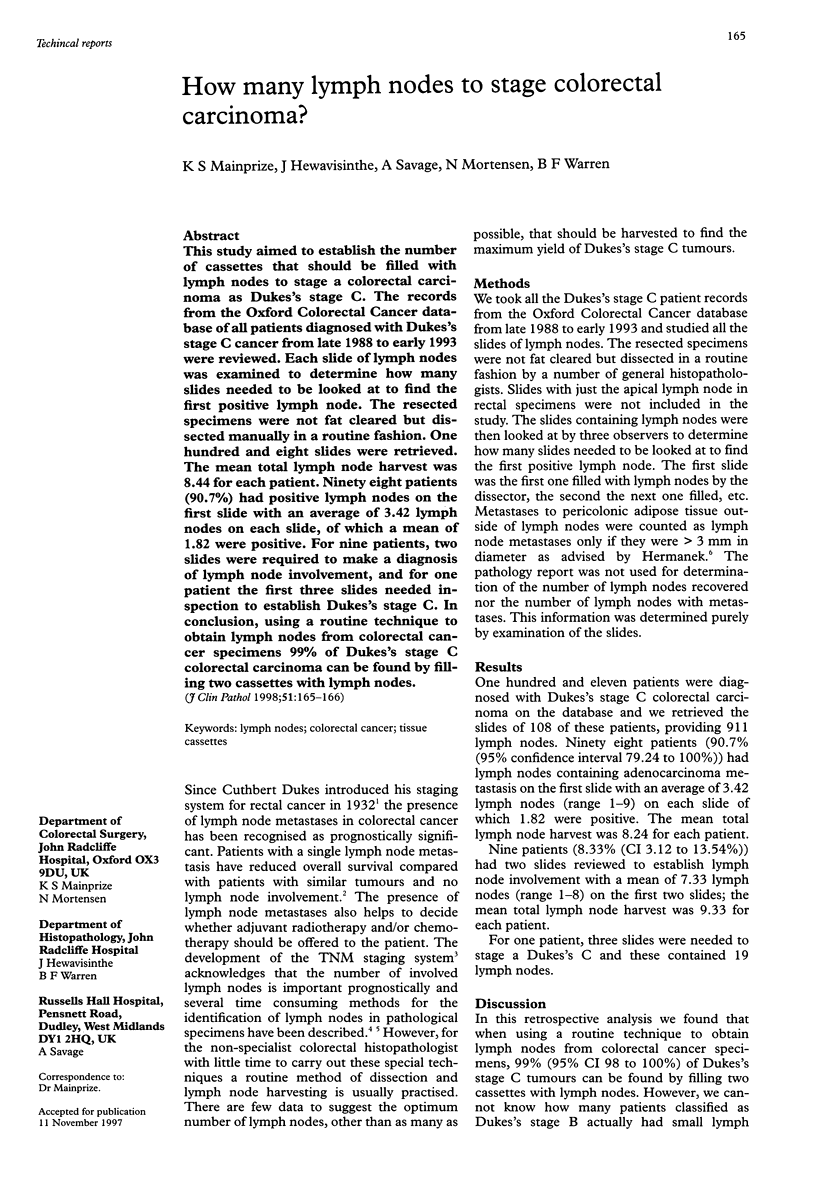Abstract
This study aimed to establish the number of cassettes that should be filled with lymph nodes to stage a colorectal carcinoma as Dukes's stage C. The records from the Oxford Colorectal Cancer database of all patients diagnosed with Dukes's stage C cancer from late 1988 to early 1993 were reviewed. Each slide of lymph nodes was examined to determine how many slides needed to be looked at to find the first positive lymph node. The resected specimens were not fat cleared but dissected manually in a routine fashion. One hundred and eight slides were retrieved. The mean total lymph node harvest was 8.44 for each patient. Ninety eight patients (90.7%) had positive lymph nodes on the first slide with an average of 3.42 lymph nodes on each slide, of which a mean of 1.82 were positive. For nine patients, two slides were required to make a diagnosis of lymph node involvement, and for one patient the first three slides needed inspection to establish Dukes's stage C. In conclusion, using a routine technique to obtain lymph nodes from colorectal cancer specimens 99% of Dukes's stage C colorectal carcinoma can be found by filling two cassettes with lymph nodes.
Full text
PDF

Selected References
These references are in PubMed. This may not be the complete list of references from this article.
- Andreola S., Leo E., Belli F., Bufalino R., Tomasic G., Lavarino C., Baldini M. T., Meroni E. Manual dissection of adenocarcinoma of the lower third of the rectum specimens for detection of lymph node metastases smaller than 5 mm. Cancer. 1996 Feb 15;77(4):607–612. doi: 10.1002/(SICI)1097-0142(19960215)77:4<607::AID-CNCR4>3.0.CO;2-D. [DOI] [PubMed] [Google Scholar]
- DUKES C. E., BUSSEY H. J. The spread of rectal cancer and its effect on prognosis. Br J Cancer. 1958 Sep;12(3):309–320. doi: 10.1038/bjc.1958.37. [DOI] [PMC free article] [PubMed] [Google Scholar]
- Gilchrist R. K., David V. C. LYMPHATIC SPREAD OF CARCINOMA OF THE RECTUM. Ann Surg. 1938 Oct;108(4):621–642. doi: 10.1097/00000658-193810000-00011. [DOI] [PMC free article] [PubMed] [Google Scholar]
- Goldstein N. S., Sanford W., Coffey M., Layfield L. J. Lymph node recovery from colorectal resection specimens removed for adenocarcinoma. Trends over time and a recommendation for a minimum number of lymph nodes to be recovered. Am J Clin Pathol. 1996 Aug;106(2):209–216. doi: 10.1093/ajcp/106.2.209. [DOI] [PubMed] [Google Scholar]
- Herrera L., Villarreal J. R. Incidence of metastases from rectal adenocarcinoma in small lymph nodes detected by a clearing technique. Dis Colon Rectum. 1992 Aug;35(8):783–788. doi: 10.1007/BF02050329. [DOI] [PubMed] [Google Scholar]
- Hutter R. V., Sobin L. H. A universal staging system for cancer of the colon and rectum. Let there be light. Arch Pathol Lab Med. 1986 May;110(5):367–368. [PubMed] [Google Scholar]
- Morikawa E., Yasutomi M., Shindou K., Matsuda T., Mori N., Hida J., Kubo R., Kitaoka M., Nakamura M., Fujimoto K. Distribution of metastatic lymph nodes in colorectal cancer by the modified clearing method. Dis Colon Rectum. 1994 Mar;37(3):219–223. doi: 10.1007/BF02048158. [DOI] [PubMed] [Google Scholar]


